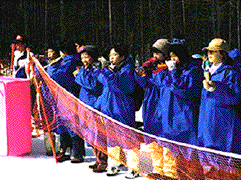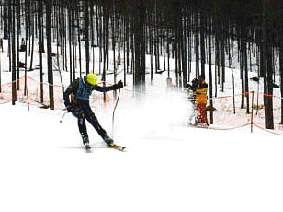 The Winter Paralympic Games were held with 1,200 athletes with disabilities from 32 countries in Nagano in March 1998, a month after the Nagano Olympics. A big factor behind the success of the Paralympic Games was the support provided by local schoolchildren.
The Winter Paralympic Games were held with 1,200 athletes with disabilities from 32 countries in Nagano in March 1998, a month after the Nagano Olympics. A big factor behind the success of the Paralympic Games was the support provided by local schoolchildren.
Saki Hashimoto, a fifth grader at Hakuba-Kita Elementary School in the village of Hakuba, where Alpine skiing events were held, was an escort runner in the Paralympic torch relay.
Hashimoto could barely walk before she attended school, but after years of training and rehabilitation, she now enjoys various outdoor sports and is an accomplished skier.
 "She doesn't seem to think of herself as being physically disabled," her mother said. "She's made a tremendous effort to be able to do what she couldn't do before," she added.
"She doesn't seem to think of herself as being physically disabled," her mother said. "She's made a tremendous effort to be able to do what she couldn't do before," she added.
Other students at Hakuba-Kita Elementary School organized a special gathering to cheer on Naoya Maruyama, a third grader at the Hakuba Middle School and an alumnus of the elementary school. Maruyama competed in Alpine skiing events as one of the youngest participants in the Games.
Students attending Matsumoto Elementary School in the city of Matsumoto held a choral concert for Tsuyoshi Honda, who competed in cross-country skiing. Honda, who is blind, works as a clerk at the Matsumoto School for the Blind.
In the city of Suzaka, meanwhile, children at Moriue Elementary School created cards with pressed flowers. The flowers used for the cards were grown by the students themselves on school grounds. The pupils made 330 such cards in all, wrote messages of encouragement on each of them, and sent them to athletes participating in the Paralympics shortly before the start of the Games.
Thanks to these contributions by local youngsters, the Nagano Paralympics left a deep and lasting impression on the participating athletes from Japan and around the world.
Photos: (Top) Local students cheer on Naoya Maruyama at an Alpine skiing event; (bottom) Maruyama was the youngest member of the Japanese Paralympic team. (Hakuba Middle School)

|